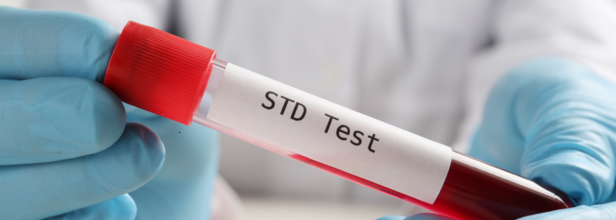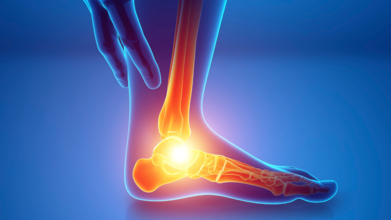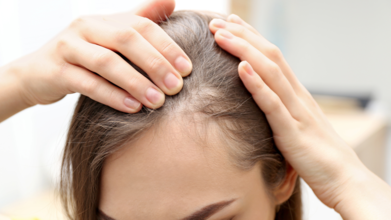- Health Conditions A-Z
- Health & Wellness
- Nutrition
- Fitness
- Health News
- Ayurveda
- Videos
- Medicine A-Z
- Parenting
- Web Stories
STI and STD Are Not The Same Thing, Know Why

Credits: Canva
Did you know that STIs and STDs are not the same thing?
While we often use the words interchangeably, they are not the same health concerns, though both happen due to sexually transmitted bacteria through bodily fluids. If you do not know the difference, do not worry, here's all that you need to know.
STIs are sexually transmitted infections, whereas STDs are sexually transmitted diseases. An STI is only considered a disease when it causes symptoms.
The Difference Between Infection and Disease
The main difference between the two is that an infection marks the beginning of a process where pathogens, like bacteria, viruses, or parasites, enter the body and start multiplying. Infections may not always cause symptoms, making them the silent precursor to diseases.
A disease is when infection damages the body’s cells, and it leads to noticeable signs and symptoms. For sexually transmitted conditions, this distinction is why experts prefer the term STI over STD, as many STIs are asymptomatic and don’t progress to diseases.
All STDs Start as STIs, But Not All STIs Become STDs
STDs begin as an infection, however, only some infections may never cause diseases, like HPV, which clears on its own. When it persists, it may turn into a genital wart or cancer, that is when it transforms into a disease.
ALSO READ: These 10 US States Have The Highest STI Cases
Common Symptoms to Watch For
STIs and STDs manifest differently. Most of it depends on the infection and the type of sexual activity one is involved. Symptoms might not appear immediately or even for years. Key signs include:
- Bumps, sores, or rashes near genitals or anus
- Painful urination or discharge from the penis or vagina
- Unusual vaginal bleeding or pelvic pain
- Swollen lymph nodes or testicles
- Rectal bleeding or itching around the genitals
What Are The Common STIs?
- Herpes (HSV-1 and HSV-2)
- Chlamydia
- Syphilis
- Gonorrhea
- Human papillomavirus (HPV)
- Trichomoniasis
- HIV/AIDS
When to Get Tested
Regular testing is crucial for sexually active individuals. The Centers for Disease Prevention and Control (CDC) recommends yearly screenings, but testing is especially important if you:
- Had unprotected sex
- Have a new or multiple partners
- Are pregnant
Suspect exposure to an STI
Testing too soon might not detect an infection, as STIs have incubation periods ranging from days to months. Consult a healthcare provider for tailored advice on testing timelines or preventive measures like PEP for HIV.
What to Do After Testing
Negative Results: Stay vigilant with routine screenings and discuss preventive strategies with your healthcare provider, like using condoms or starting PrEP for HIV prevention.
Positive Results: Treatment varies by infection. Bacterial STIs are typically treated with antibiotics, while viral STIs require antiviral medications for symptom management. Always notify partners for testing and treatment to prevent further spread.
Are There Any Food That Can Help You Against STI?
- Ginger: used to kill off oral pathogens
- Garlic: contains antiviral, antibacterial, and antifungal properties
- Honey: it contains hydrogen peroxide, methylglyoxal, and peptide bee defensin, and has a low pH and antibacterial properties
- Cabbage: it is a detoxifying food with antibacterial properties
- Horseradish: it is used to treat UTIs
- Coconut Oil: it also has antiviral, antibacterial, and antifungal properties
- Apple cider vinegar: it is known to be an at-home treatment for warts
- Turmeric: it has powerful anti-inflammatory properties and is also an antibacterial
- Cranberry Juice: it has antibacterial properties
Understanding Chronic Regional Pain Syndrome: When Pain Persists Beyond Injury

Imagine stubbing your toe and feeling like it's been set on fire... for months. Now imagine that burning sensation spreading to your entire leg, and instead of easing over time, it gets worse. That’s Chronic Regional Pain Syndrome (CRPS). It is a condition as problematic as its name suggests and yet, bizarrely, not talked about enough.
Chronic Regional Pain Syndrome is a long-term, often debilitating condition that typically affects a limb like an arm, hand, leg, or foot after an injury, surgery, stroke, or even something as mundane as a sprain. It’s like your nervous system gets stuck in panic mode.
There are two types:
Type 1 (Reflex Sympathetic Dystrophy): Happens without a confirmed nerve injury.
Type 2 (Causalgia): Involves a definite nerve injury.
Regardless of type, the result is the same: persistent, severe pain way out of proportion to the initial injury, often with odd side effects.
Why CRPS Is No Ordinary Ache
If pain had a reality show, CRPS would be the melodramatic diva. The pain can feel like burning, stabbing, throbbing, or shooting. It’s often accompanied by:
- Swelling
- Changes in skin colour or temperature (hot and red one minute, cold and blue the next)
- Excessive sweating
- Hair and nail changes
- Muscle weakness and spasms
It can also cause allodynia, which is a fancy term for when even a gentle breeze or the touch of fabric feels like torture.
Worst of all? The pain doesn’t stay neatly in one place. It may start in a toe and sneakily creep up the leg or even jump to the other side of the body.
Why It Happens
Ask ten doctors what causes CRPS, and you might get eleven guesses. The exact cause isn’t fully understood, but it seems to involve:
- A malfunction in the peripheral and central nervous systems
- Abnormal inflammatory responses
- Dysfunction of blood vessels and pain pathways
- It’s the body’s overreaction to trauma, like a car alarm blaring long after the bump is gone.
Life with CRPS
Chronic pain doesn’t just hurt the body; it impacts daily life. CRPS affects every layer of existence:
- Mental health: Anxiety, depression, and even PTSD-like symptoms are common.
- Mobility: Limited range of motion and muscle weakness may lead to reliance on walking aids or wheelchairs.
- Sleep: Pain that flares up at night makes good sleep feel like a luxury.
- Work and relationships: Jobs may be lost, plans cancelled, social life drained.
What adds to the distress? Many people with CRPS report feeling disbelieved, even by medical professionals. It’s an invisible illness with painfully visible consequences.
How Do You Treat It?
There’s no one-size-fits-all cure, but the goal is to reduce symptoms and improve quality of life. Treatment is usually multi-pronged:
- Medications: Pain relievers, nerve-blockers, antidepressants, anticonvulsants
- Physical therapy: To restore mobility and function
- Occupational therapy: To adapt daily tasks
- Psychological support: Pain management techniques like CBT and mindfulness
- Interventional approaches: Nerve blocks, spinal cord stimulation, or ketamine infusions in severe cases
Early diagnosis is key. The longer CRPS goes untreated, the more entrenched and resistant it becomes.
CRPS Is Real, Rare, and Relentless
Though CRPS is considered rare, with estimates suggesting around 5 to 26 cases per 100,000 people annually, it’s devastating for those who live with it. It often shows up uninvited, stays far too long, and brings along a suitcase full of complications.
But awareness is growing. Support groups, research into new treatments, and advocacy efforts are helping give a voice to people who’ve lived in silence. With the right treatment plan, support system, and a dash of stubborn hope, many people find ways to live well despite the pain.
When Hair Falls, Look at Your Plate: Why Sudden Thinning Could Be a Nutrient SOS

We have all had that mini meltdown finding a clump of hair in the shower drain or a brush full of hair after combing hair. While blaming stress or the changing seasons feels comforting, experts warn that your body might be sounding a nutritional alarm. Yes, your hair loss might be less about the weather and more about what is missing from your plate.
Listen to What Your Body’s Saying
“Seeing a lot of hair strands on your pillow cover feels distressing,” says Dr Khushboo Jha, MBBS, MD, Chief Dermatologist Consultant at Metro Hospital and Founder of One Skin Clinic, Faridabad, “but you need to listen to your body. It’s the way it communicates that your body is struggling with some deeper concern, probably nutrient deficiency.”
Hair, it turns out, is a high-maintenance tissue. It’s fast-growing and metabolically active, demanding a steady supply of nutrients. But it’s not considered essential for survival. So in times of nutritional crisis, your body reroutes vitamins and minerals to more important organs like your heart or brain, leaving your hair stranded without support.
“If your diet is insufficient, especially lagging in iron, vitamin D, Vitamin B complex such as vitamin B12 and biotin, zinc, protein, etc., hair will be the first one to suffer,” says Dr Jha.
Why Vegans, Crash Dieters, and IBS Patients Should Pay Extra Attention
The hair-nutrition connection is especially crucial for those following restrictive diets. Dr Jha warns that vegetarians and vegans “may unknowingly miss out on essential nutrients, particularly iron and protein, leading to diffuse thinning or excessive shedding.”Dr Ameesha Mahajan, Cosmetic Dermatologist and Founder of Eden Skin Clinic, agrees. “Vegetarians or vegans are more prone to deficiencies, especially when it comes to vitamin B12, iron and protein deficiency,” she says. And it’s not just about what you eat, but also how well your body absorbs it. “Impaired gut absorption disorders such as coeliac disease or IBD… can lead to extreme hair thinning,” Dr Mahajan adds.
Crash diets and eating disorders like bulimia nervosa don’t do your strands any favours either. These behaviours disrupt the body’s nutritional balance and can prematurely push hair into the shedding phase.
The Medical Jargon You Didn’t Know You Needed: Telogen Effluvium
One particular fallout of nutrient shortfalls is telogen effluvium, a name for hair falling out sooner than it should. Dr Mahajan points to iron deficiency anaemia as a common trigger. “It is strongly associated with telogen effluvium, a condition where hair prematurely enters the shedding phase,” she explains.
In other words, if you’ve been feeling unusually tired and your hair is thinning, it might be more than a coincidence; it could be low iron or another nutrient throwing your hair growth cycle off track.
Don’t Pop Just Any Pill
Before you go on a supplement shopping spree, both experts urge caution. “Before self-prescribing supplements, experts urge a full nutritional workup to identify what’s missing,” says Dr Jha. Overloading on certain vitamins can do more harm than good.
Dr Mahajan agrees. “It’s best to get blood parameters checked for any nutrient deficiencies before beginning any supplement to be sure.”
So yes, multivitamins are tempting but flying blind could backfire. Know what you’re low on before topping up.
Eat for Your Hair: What to Load on Your Plate
Both dermatologists suggest nourishing your scalp from within. Dr Jha recommends “a diet loaded with whole grains, legumes, millets, dairy products, nuts, seeds, etc.,” noting these support not only hair health but also overall wellbeing.
Dr Mahajan says that these foods “help to restore the lost nutrients, making the hair denser and thicker.” Think of them as edible armour for your follicles.
Still Losing Hair? Time to Dig Deeper
If your hair continues to vanish despite eating all the right things, don’t ignore it. “If still you face symptoms, consult a dermatologist for ruling out hormonal or other health conditions,” advises Dr Jha.
Dr Mahajan adds, “If you still suffer from hair fall, despite making changes in your diet, it’s time to consult a dermatologist, as it might be due to some hormonal disruption or any other autoimmune-related cause.” Because sometimes, hair loss isn’t just about what’s missing but what’s going wrong beneath the surface.
Inner Child: How ‘Be a Good Girl’ and ‘Boys Don’t Cry’ Create Adults Who Struggle to Say What They Really Feel

When was the last time you said yes when you wanted to scream no? Or brushed off your tears with an “I am fine” when you were anything but? If that sounds familiar, chances are your inner child is still living by the outdated scripts of “Be a good girl” or “Boys don’t cry.” These innocent-sounding childhood phrases may seem harmless, even well-intentioned. But dig a little deeper and you will find they are often the root of emotional repression, people-pleasing, and communication struggles that trail into adulthood.
Here is a look at the emotional luggage that comes with these tags and why it is time to give your inner child a much-needed rewrite.
Politeness Over Authenticity
“Be a good girl” is often code for “Don’t make trouble.” For many girls, this message translates into a lifelong performance of compliance, agreeability, and emotional restraint. Crying too much? You are dramatic. Asking for what you need? You are selfish. Angry? That is unladylike.As adults, these same girls may find themselves constantly apologising, afraid to take up space, and saying “yes” when their gut screams “no”. This chronic need to be nice can cause serious emotional strain, often leading to burnout, resentment, or difficulty setting boundaries in relationships and at work.
Emotion is Weakness
Then there is the classic dialogue: “Boys don’t cry,” meaning, emotions are unmanly. From a young age, boys are conditioned to internalise their feelings, tough it out, and “man up”. Due to this, adults who may feel shame over vulnerability struggle with emotional literacy and bottle up feelings until they explode or implode.This emotional suppression can make it harder for men to maintain close relationships, express love, or seek help when struggling with anxiety or depression. Worse, many don’t even have the language to articulate what they are feeling in the first place.
What Happens When Children Swallow Their Feelings
Psychologists often speak of the “inner child” as the part of us that holds onto early emotional experiences. When children are routinely told to suppress emotions or follow behavioural templates that do not honour their individuality, that inner child grows up confused and disconnected from their authentic self.This can lead to:
- Emotional Dysregulation: If children are not taught how to safely express anger, sadness, or fear, they grow into adults who either overreact or emotionally shut down.
- Low Self-Esteem: Constantly editing oneself to please others sends the message, “I am only lovable when I behave a certain way.”
- Chronic People-Pleasing: The fear of rejection or disappointing others can lead to saying yes to everyone but yourself.
- Passive-Aggressive Communication: Since direct expression feels unsafe, emotions find backdoor exits through sarcasm, guilt-tripping, or silent treatment.
- Difficulty in Intimacy: When vulnerability feels dangerous, closeness becomes difficult. This often plays out in romantic or familial relationships.
How Gender Scripts Shape Personality
Over time, these gendered expectations do not just influence how we behave; they shape our personalities. The good girl might grow into the overly agreeable woman who cannot advocate for herself at work. The “don’t cry” boy may become the emotionally distant partner who changes the subject every time feelings come up. These personas can feel so fused with our identity that we do not realise they are scripts we were handed, not who we truly are.Breaking the Pattern by Reparenting the Inner Child
These patterns are not fixed. With awareness, therapy, and emotional work, we can begin to reparent our inner child. This means offering ourselves the validation, acceptance, and emotional permission we did not receive as kids.- Start by recognising the outdated beliefs you are living by. Ask yourself: Who told me this was true?
- Feel the Feelings: Let yourself cry, rage, or say no. You are not being dramatic; you are being human.
- Practise Assertiveness: Saying what you feel does not make you bad or weak. It makes you honest and honesty builds real connection.
- Replace Labels With Language: Instead of “good” or “strong”, teach children and yourself words like “authentic”, “brave”, “kind”, or “vulnerable”.
- Model Emotional Intelligence: Whether you are a parent, sibling, partner, or friend, showing emotional expression is a gift to everyone around you.
A New Story for the Inner Child
The goal is not to blame our parents or teachers; many of them repeated what they were told. The goal is to break the cycle. If your inner child is still trying to be the “good girl” who never complains or the “tough guy” who never cries, it is time to let them off the hook. Being a full human, who is messy, emotional, and honest, is far more powerful than being a stereotype.© 2024 Bennett, Coleman & Company Limited

